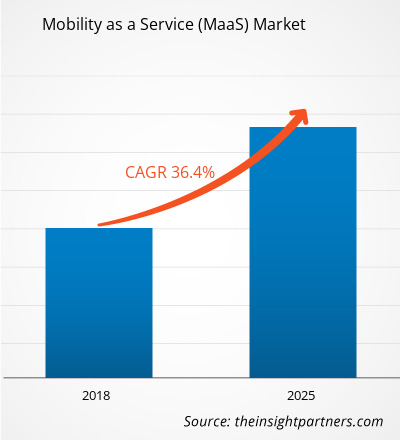[研究报告] 2017 年出行即服务 (MaaS) 市场规模为 443.3 亿美元,预计到 2025 年将达到 4763.4 亿美元;预计 2018 年至 2025 年的复合年增长率为 36.4%。
分析师观点:
近年来,出行即服务 (MaaS) 市场经历了快速增长和转型。MaaS 是指将公共交通、拼车、共享单车和共享汽车等各种交通方式整合到一个平台或服务中,为用户提供无缝便捷的交通体验。随着对可持续高效交通解决方案的需求不断增长、技术进步以及共享经济的兴起,MaaS 市场获得了显著发展。 MaaS 平台通常为用户提供一系列选项,包括实时出行信息、预订和支付服务以及个性化路线规划,所有这些功能都可通过移动应用程序或在线平台访问。MaaS 市场的主要驱动力之一是全球城市化进程的加快和交通拥堵。随着越来越多的人迁入城市,高效的交通变得至关重要。MaaS 旨在通过为用户提供根据其特定需求定制的全面交通选择来应对这些挑战。这有助于减少对私家车的依赖,缓解交通拥堵,并提高整体交通效率。移动连接、GPS 和数据分析等数字技术的进步,使得 MaaS 平台能够无缝集成不同的交通方式。这种集成使用户能够使用单个应用程序规划、预订和支付整个行程,无需使用多张票或单独的支付系统。从用户的出行模式和偏好中收集的数据可用于优化交通网络、提高服务质量并提升整体用户体验。MaaS 市场也见证了包括交通运营商、技术提供商和政府在内的利益相关者之间日益加强的合作。公私合作伙伴关系正在形成,旨在构建将公共交通与私人出行服务相结合的 MaaS 生态系统。各国政府认识到 MaaS 在应对交通挑战方面的潜力,并通过政策框架和资助计划积极支持其实施。
市场概览:
“出行即服务”是一种以客户为中心的交通理念。该服务允许客户规划、预订和支付各种出行服务。它通过数字渠道整合了出租车、汽车租赁/租借以及自行车和汽车共享等交通选择。MaaS 发展的主要目标是为旅行者提供量身定制的出行解决方案,以满足他们的出行需求。
自定义此报告以满足您的要求
您将免费获得任何报告的定制,包括本报告的部分内容,或国家级分析、Excel 数据包,以及为初创企业和大学提供超值优惠和折扣
出行即服务 (MaaS) 市场: 战略洞察

- 获取本报告的主要市场趋势。这个免费样本将包括数据分析,从市场趋势到估计和预测。
您将免费获得任何报告的定制,包括本报告的部分内容,或国家级分析、Excel 数据包,以及为初创企业和大学提供超值优惠和折扣
出行即服务 (MaaS) 市场: 战略洞察

- 获取本报告的主要市场趋势。这个免费样本将包括数据分析,从市场趋势到估计和预测。
市场驱动力:
城市化进程加快和智慧城市计划推动出行即服务市场增长
城市化进程加快和智慧城市计划在推动出行即服务 (MaaS) 市场发展方面发挥着至关重要的作用。随着全球各地的城市都在努力应对人口密度上升、交通拥堵和环境问题,MaaS 的概念应运而生,成为应对这些挑战的一种有前景的解决方案。城市化导致城市人口更加集中,从而对高效可持续的交通方式的需求也随之增加。MaaS 通过将各种交通方式(例如公共交通、拼车、共享单车,甚至自动驾驶汽车)整合到一个平台,为出行提供了一种整体解决方案。这种集成方法使城市居民能够便捷地规划、预订和支付行程,摆脱对私家车的单一依赖。通过 MaaS 提供多样化的交通选择,城市可以减少交通拥堵,缓解停车问题,并提高整体交通效率。智慧城市计划利用技术和数据优化城市出行,进一步推动了出行即服务 (MaaS) 的发展。智慧城市部署智能交通系统、传感器和互联互通技术,以收集交通模式、停车位可用性和公共交通利用率的实时数据。这些数据随后被用于开发预测算法,并通过 MaaS 平台向用户提供个性化推荐。通过利用技术和数据驱动的洞察,MaaS 使城市能够提供无缝高效的交通服务,最终改善居民的生活质量。
此外,智慧城市计划通常优先考虑可持续性和环境因素。MaaS 通过推广共享出行、减少对私家车的依赖,并将电动汽车融入交通生态系统,与这些目标完美契合。通过 MaaS,城市可以鼓励公共交通、拼车和其他环保交通方式,从而减少碳排放并改善空气质量。这种与可持续发展目标的契合,使 MaaS 成为寻求打造更绿色、更宜居城市环境的智慧城市的理想解决方案。此外,数字支付系统、互联出行平台和智能交通枢纽等智慧城市基础设施为 MaaS 部署奠定了坚实的基础。这些技术进步促进了不同交通方式的无缝集成,使用户能够轻松访问和支付服务费用。MaaS 平台提供的便利性和易用性鼓励更多人采用可持续的多式联运交通方式,从而进一步推动市场增长。
细分分析:
根据应用平台,市场分为 Android、iOS 和其他。Android 细分市场在 2020 年占据了出行即服务市场的最大份额,预计在预测期内将实现最高的复合年增长率。Android 细分市场已成为出行即服务 (MaaS) 市场的领导者,占据了最大的份额。这可以归因于广泛的采用、开源特性、与各种硬件和连接选项的兼容性、强大的应用生态系统以及与其他 Google 服务的集成。 Android 庞大的用户群、广泛的开发者社区以及各种 MaaS 应用程序和解决方案的可用性,使其在市场上占据主导地位。此外,Android 与谷歌地图的集成及其对多种交通方式的支持能力,巩固了其作为 MaaS 提供商首选平台的地位。
区域分析:
2017 年亚太地区出行即服务市场价值为 162.3 亿美元,预计到 2025 年将达到 1982.9 亿美元;预计在预测期内的复合年增长率为 38.9%。亚太地区已成为出行即服务 (MaaS) 市场的领导者,并因几个关键因素而占据突出地位。该地区快速的城市化和人口增长对高效和可持续的交通解决方案产生了强劲的需求。中国、印度、日本和韩国等国家的人口稠密城市面临着严重的交通拥堵和污染挑战。 MaaS 提供了一种极具前景的解决方案,它提供集成式多式联运方案,使用户能够轻松驾驭城市环境。亚太地区见证了显著的数字基础设施和移动技术进步。凭借智能手机的高普及率和移动互联网的广泛接入,该地区具备良好的条件来支持 MaaS 平台和服务。韩国和日本等以率先采用科技而闻名的国家,其科技水平较高的人口进一步推动了该地区 MaaS 的发展。
此外,政府的支持性政策和举措在促进亚太地区 MaaS 的发展方面发挥了至关重要的作用。新加坡和中国等国的政府积极推动智慧城市计划和可持续交通系统,并提供激励措施和监管框架来鼓励 MaaS 的采用。这些努力为 MaaS 提供商的运营和扩展服务创造了有利环境。Grab、Gojek 和滴滴出行已建立强大的影响力,提供超越传统网约车的广泛出行服务,包括共享单车、共享汽车和综合交通平台。这些公司已经建立了广泛的网络和用户群,推动了该地区 MaaS 的全面普及。此外,亚太地区的文化和地理多样性也为 MaaS 提供商提供了独特的机遇。不同国家/地区的交通需求和偏好各不相同,因此需要定制化和本地化的解决方案。能够根据每个市场的具体需求调整服务的 MaaS 提供商在该地区获得了竞争优势。
出行即服务 (MaaS) 市场区域洞察
The Insight Partners 的分析师已详尽阐述了预测期内影响出行即服务 (MaaS) 市场的区域趋势和因素。本节还探讨了北美、欧洲、亚太地区、中东和非洲以及南美和中美洲的出行即服务 (MaaS) 市场细分和地域分布。
出行即服务 (MaaS) 市场报告范围
| 报告属性 | 细节 |
|---|---|
| 市场规模 2017 | US$ 44.33 Billion |
| 市场规模 2025 | US$ 476.34 Billion |
| 全球复合年增长率 (2017 - 2025) | 36.4% |
| 历史数据 | 2015-2016 |
| 预测期 | 2018-2025 |
| 涵盖的领域 |
By 服务类型
|
| 覆盖地区和国家 | 北美
|
| 市场领导者和主要公司简介 |
|
出行即服务 (MaaS) 市场参与者密度:了解其对业务动态的影响
出行即服务 (MaaS) 市场正在快速增长,这得益于终端用户需求的不断增长,而这些需求的驱动因素包括消费者偏好的演变、技术进步以及对产品优势的认知度的提升。随着需求的增长,企业正在扩展其产品线,不断创新以满足消费者需求,并抓住新兴趋势,从而进一步推动市场增长。

- 获取 出行即服务 (MaaS) 市场 主要参与者概述
关键参与者分析:
出行即服务市场分析涵盖的参与者包括 Lyft, Inc.、Uber Technologies, Inc.、Moovel Group GmbH、Beeline Singapore、Whim App (MaaS Global Oy)、Splyt Technologies Ltd.、Qixxit、UbiGo AB、Tethys Technology, Inc.、Smile Mobility、SkedGo Pty Ltd、Transit Systems Pty Ltd. 和 Citymapper。在出行即服务参与者中,Moovel Group GmbH 和 Smile Mobility 凭借其多样化的产品组合位居前两位。
近期发展:
出行即服务市场中的公司广泛采用并购等有机和无机战略。以下列出了一些近期的关键市场发展:
- 2022 年 8 月,电动汽车公司 Lime 和出行应用程序 Whim 将合作扩展到其他国家。 2022年6月,Whim在比利时安特卫普和布鲁塞尔推出了电动滑板车,随后在芬兰赫尔辛基也推出了电动滑板车。Whim目前已接入苏黎世、温特图尔和巴塞尔的所有Lime电动滑板车。Whim与另外两家电动滑板车供应商合作,覆盖十多个城市,允许用户使用多种交通方式规划、预订和支付行程。
- 2022年5月,FOD Mobility Group为Mobilleo客户推出了定制化的营销支持服务。FOD Mobility Group现在为缺乏必要营销经验或内部资源的客户提供全面的定制化营销支持服务,此外,它还通过其市场领先的移动平台提供出行即服务 (MaaS) 技术。
- 历史分析(2 年)、基准年、预测(7 年)及复合年增长率
- PEST和SWOT分析
- 市场规模、价值/数量 - 全球、区域、国家
- 行业和竞争格局
- Excel 数据集
近期报告
客户评价
购买理由
- 明智的决策
- 了解市场动态
- 竞争分析
- 客户洞察
- 市场预测
- 风险规避
- 战略规划
- 投资论证
- 识别新兴市场
- 优化营销策略
- 提升运营效率
- 顺应监管趋势




















 获取免费样品 - 出行即服务 (MaaS) 市场
获取免费样品 - 出行即服务 (MaaS) 市场